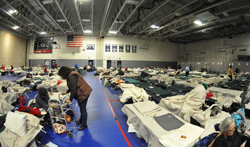A series of hurricanes, earth quakes, and wild fires within the last month have caused local concern over the vulnerability of coastal residency and the effects of climate change.
The most recent hurricane developing is Hurricane Maria. According to Dr. Thomas Herrington, Associate Director of the Urban Coast Institute, “Maria made landfall in Puerto Rico [Wednesday, Sept. 20] as a very strong Category 4 hurricane. It was really close to being a Category 5. The mountains in Puerto Rico weakened Maria down to a Category 3 hurricane.”
According to Herrington, the storm is expected to move northwest across the ocean, and be well offshore of the United States coast as a Category 1 hurricane. Hurricane Maria is unlikely to cause any severe damage to the local community in Long Branch.
“The only danger to NJ is continued high surf and rip currents that have been occurring since Jose moved passed us,” said Herrington.
Many members of the University community have families living in areas that have been severely affected by the recent hurricanes. “I started to see pictures on Facebook of the places where I grew up and they are unrecognizable. It’s hard to see these images and contemplate that this is happening to my island, and what is worse, this is not the first storm of the season for them.”
Zach Gindi, a senior music industry student, expressed concern for his family’s safety and acknowledged the increased frequency of these hurricanes.
“These hurricanes seem to be coming one after the other,” Gindi said. “My family in Miami was affected by Hurricane Irma, which lasted from Aug. 30 to Sept. 15. They had to evacuate and still have no power at our home in Miami.”
The frequency of storms can be attributed to a meteorological weather pattern known as ‘hurricane season’.
Herrington defines this as “the period between June 1 and Nov. 31, when climatologically the tropical ocean has conditions favorable for the development of tropical storms and hurricanes.”
Herrington went on to explain that conditions required for hurricane development include ocean water temps above 86 F, light winds almost up to 30,000 ft. above the ocean, and numerous thunderstorms over the tropical ocean.
While hurricane season usually takes place between June and November, there have been tropical storms that have formed both earlier and later than those dates.
There is much speculation that the severity of this hurricane season is due to a climate crisis called climate change. The correlation between increased air temperature and water temperature is a factor in the increased severity and frequency of the storms.
“Warm water and air fuels hurricanes, hence why they persist in tropical waters,” said Tiffany Medley, Ph.D., a lecturer of biology. “Therefore, with increasing air and ocean temperatures you would expect stronger storms.”
“I do believe that the intensity of hurricanes is increasing due to increased ocean water temperatures which are a result of a warming atmosphere,” said Herrington. “The warmer the ocean and air, the more moisture can evaporate from the ocean and the more water vapor the air can hold. It is the amount of water vapor rising and cooling in hurricanes that gives them their energy. ”
“Right now, it is hard to link an increased frequency of tropical storms and hurricanes to climate change because there are so many factors that go into the generation of these storms…some of which we still don’t fully understand at this point,” he continued.
Monmouth University, being about one mile from the coast, has a variety of precautionary measures to protect the community from severe storms including an Emergency Operations Plan (EOP).
Patricia Swannack, Vice President of Administrative Services, clarified, “The University’s Emergency Operations Plan is updated annually by our police department and various University administrators, reviewed by our Board of Trustees every five years, and certified with the state.
The EOP includes numerous policies and procedures including, but not limited to, emergency management plan, emergency shelter, emergency notifications, natural disaster, power outage policy, relocation of resident students, etc.”
Monmouth has off-campus housing located on the shore-line that is also protected under the EOP.
Swannack added that when faced with super-storm Sandy in 2012, “Bluffs residents were evacuated at the end of the week before super-storm Sandy hit. Residential life and MUPD ensured that students left and either went home or were relocated. The Bluffs however faced minimal damage as they are located on a bluff, high above the water.”
“If Godzilla came and destroyed the homes of thousands in popular cities like Houston Texas and Miami Florida, with promise to destroy countless others in the future, wouldn’t one assume that most of the funding we have for military and other crisis funds would be put into preventing attacks from Godzilla?” said Herrington. “With a mindset such as this, it would seem wise to devote funding to prevention and research of climate change.”
IMAGE TAKEN from monmouth.edu



